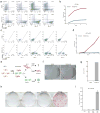Small molecules facilitate rapid and synchronous iPSC generation
- PMID: 25262205
- PMCID: PMC4326224
- DOI: 10.1038/nmeth.3142
Small molecules facilitate rapid and synchronous iPSC generation
Abstract
The reprogramming of somatic cells into induced pluripotent stem cells (iPSCs) upon overexpression of OCT4, KLF4, SOX2 and c-MYC (OKSM) provides a powerful system to interrogate basic mechanisms of cell fate change. However, iPSC formation with standard methods is typically protracted and inefficient, resulting in heterogeneous cell populations. We show that exposure of OKSM-expressing cells to both ascorbic acid and a GSK3-β inhibitor (AGi) facilitates more synchronous and rapid iPSC formation from several mouse cell types. AGi treatment restored the ability of refractory cell populations to yield iPSC colonies, and it attenuated the activation of developmental regulators commonly observed during the reprogramming process. Moreover, AGi supplementation gave rise to chimera-competent iPSCs after as little as 48 h of OKSM expression. Our results offer a simple modification to the reprogramming protocol, facilitating iPSC induction at unparalleled efficiencies and enabling dissection of the underlying mechanisms in more homogeneous cell populations.
Conflict of interest statement
None of the authors have competing financial interests
Figures





References
-
- Takahashi K, Yamanaka S. Induction of pluripotent stem cells from mouse embryonic and adult fibroblast cultures by defined factors. Cell. 2006;126:663–676. - PubMed
-
- Yu J, et al. Induced pluripotent stem cell lines derived from human somatic cells. Science. 2007;318:1917–1920. - PubMed
-
- Takahashi K, et al. Induction of pluripotent stem cells from adult human fibroblasts by defined factors. Cell. 2007;131:861–872. - PubMed
Publication types
MeSH terms
Substances
Grants and funding
LinkOut - more resources
Full Text Sources
Other Literature Sources
Medical
Molecular Biology Databases
Research Materials

